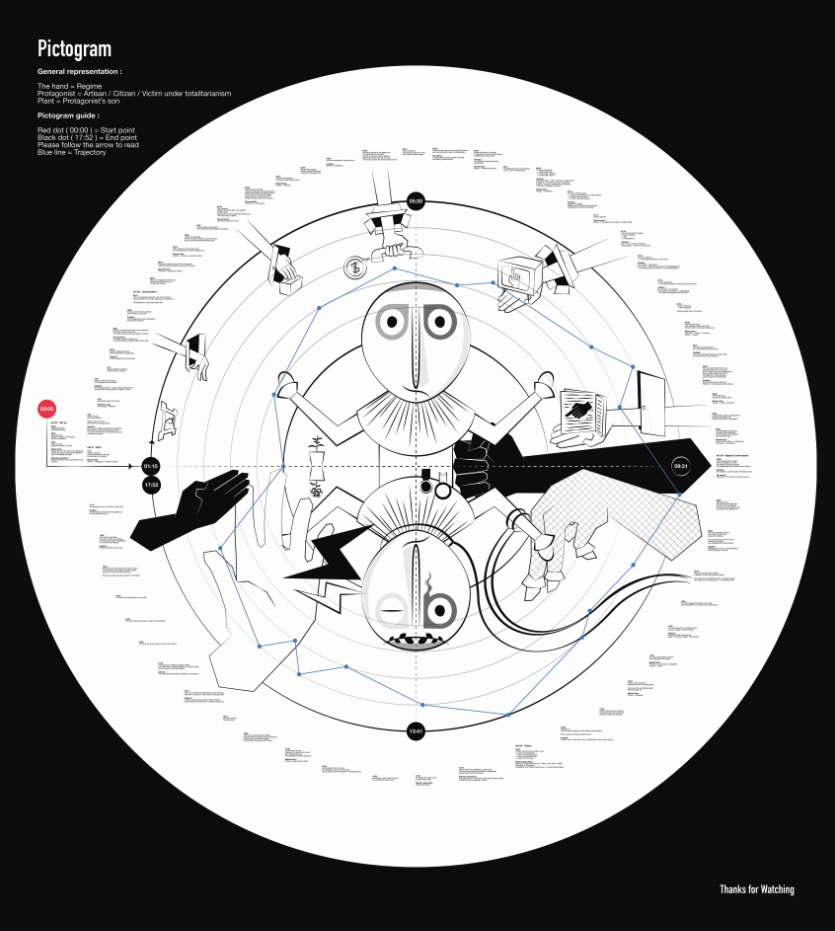The Hand comes in from everywhere. It interrupts, commands, dominates…; it is omnipresent, irresistible, almighty, dressed and decorated nonetheless mercilessly brutal.. Such is the condition of an artist who wakes up one morning to find his normal routine totally ruled invalid. 木偶藝術小子一覺醒來,伸伸懶腰又期待著新一天的開始。怎知道一夜間世界變透了。一隻無名的手,由溫柔禮待到強權粗暴,又如天眼無處不在,針對性的無孔不入… …。
The Ventriloquists…Thinking Narratively 4-19 July 2020 @ Floating Projects. 2-8pm daily except Mondays | Daily newsletter to the show The Ventriloquists Series 《腹語系》每日通訊。
+ + + +
 ^Jiri Trnka (1912-1969, Czechoslovakia): The Hand (1965, 18 minutes)
^Jiri Trnka (1912-1969, Czechoslovakia): The Hand (1965, 18 minutes)
Watch the original animation: https://vimeo.com/116020986
The Hand was Jiri Trnka’s last film. Unlike his previous works, it is an explicit political allegory. Following a classical 3-act structure, Trnka combines his typical ordinary-person puppet and live action; this time, the puppet is an artist whose cosy studio is constantly “invaded” by a Hand that grows in size and hostility. The Hand first comes in through the door and window, then starts to storm in from virtually everywhere including in news media on TV and print. Act 1 invasion is followed by Act 2 imprisonment whereby the artist is forced to create strictly what Hand assigns like a forced labourer behind bars. After a dramatic escape at the climatic closure of Act 2, Act 3 grows dimmer as the Artist’s hiding back in his studio simply results in his final destruction, followed by an epilogue that is his funeral, turned into a State spectacle of glorifying and mourning for a sacrificial hero. The narrative of The Hand parallels Trnka’s real life encounters in his final years. (Linda C.H. Lai)
“When The Hand was released it was officially declared as Trnka’s criticism of the Cult of Personality (Stalin), but for all people, it was an alarming allegory of human existence in a totalitarian society. … Trnka, for the first time, openly expressed his opinion about his own inhuman totalitarian society. The Hand was one of the first films that helped to open the short Prague’s Spring. It is curious that Trnka predicted his own fate in it. When Jiri Trnka died in November 1969 (at only 57 years of age), he had a State funeral with honours. Only four months later, The Hand was banned; all copies were confiscated by the secret police, put in a safe and the film was forbidden for screening for next twenty years.” [source…]
Research points for narrative studies: Parametric narration, the hand as a seed for generative thinking, absence Vs presence, imbalance; animated narrative; political allegory, irony
The two pictograms in this exhibition show two artists’ narrative analysis to the work, each with attention to different aspects of the work. Whereas Steven Tsang highlights a strictly downward fall to hell (death), Brian Ng feels for the recurrent trap of interference. Both pictograms turn the original animation picture into a double story embodied in a single narrative.
 pictogram on Jiri Trnka’s The Hand by Steven Tsang
pictogram on Jiri Trnka’s The Hand by Steven Tsang
1
TSANG Chun-leung, Steven
A pictogram on Jiri Trnka’s The Hand
The pictogram I have made is an analysis of the original animation picture following its timeline, not only of the content, but also character, emotions, actions and musical aspects.
This pictogram focuses on the theme of our “reaction to destiny,” in the form of a timeline, to mark out the ideology as a generative process. While a small plant is the seed of the subsequent conflicts, a large part of the events revolve around the confrontation between the doll and the hand. The work’s generative process intensifies alongside the action and reaction between the hand and the doll. I have also included other elements such as a graph indicating a three-act structure, to show the dynamic of the work as a time-based narrative. I consider this an important aspect as the same object, such as the hand, represent very different meanings by studying the unfolding process of the narrative. The pictogram of The Hand highlights generative thinking and the presentation of ideology as a series of representation of the same object in multiple iterations. (Steven Tsang)
2
NG Sing-yiu, Brian: The Hands Around You
A Pictogram of the animation The Hand (1965)
The Hand was made by Czech Jiri Trnka in 1965, during the Cold War period. In this work, Trnka shows, from an individual person’s point of view, how easily one could become a slave under dictatorship. As an art-worker himself, Trnka knew that totalitarianism was a horrible threat for artistic creativity. I deem the protagonist of The Hand is Jiri Trnka himself, and this animation picture is his self-portrait. Three years after the work’s release, Prague Spring happened in 1968, resulting in the Soviet Union’s army occupying Czechoslovakia…
In my analytical pictogram, I illustrate how “the hand” takes control over the artisan (the protagonist). After a generative principle, I turn the idea of a hand into a seed: to show how it grows bigger successively and gradually occupies the centre of the artisan’s living and mental space. My pictogram also calls attention to a comparison between the artisan’s hand and the regime’s. (Brian Ng)
 The Hands Around You, a pictogram on Jiri Trnka’s The Hand] by Brian Ng
The Hands Around You, a pictogram on Jiri Trnka’s The Hand] by Brian Ng



